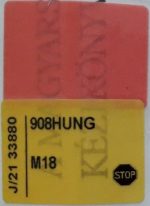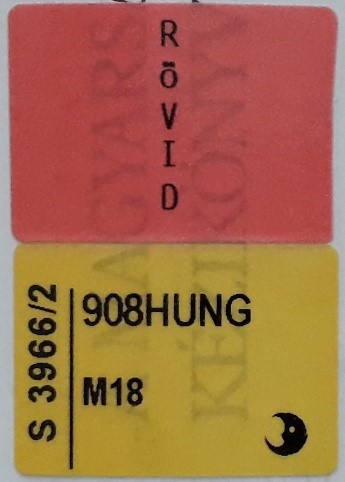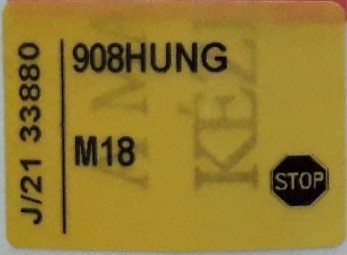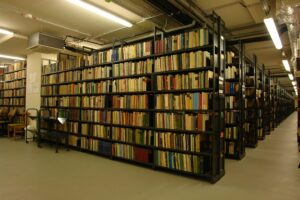- Home
- All Courses
- Contemporary library and information skills
Curriculum
- 9 Sections
- 31 Lessons
- 14 Weeks
- Introduction3
- 1) Library basicsThe main types of documents covered in these lessons, and the principles of the organisation and retrieval of library collections.3
- 2) Library use in the SZTE Klebelsberg LibraryThe chapter provides help on how to find and use the printed documents of the SZTE Klebelsberg Library, including the online options.6
- 3.1Video lesson: Library tour16 Minutes
- 3.2Video lesson: The SZTE Klebelsberg Library’s website9 Minutes
- 3.3Reading lesson: Printed documents in the SZTE Klebelsberg Library30 Minutes
- 3.4Reading lesson: Print periodicals30 Minutes
- 3.5Reading lesson: Encyclopedias and Lexicons – from glossaries to online forms30 Minutes
- 3.6Knowledge check – Library use23 Questions
- 3) Search the Library 1: online catalogue(s)This chapter covers the basics of database searching. It introduces the online catalogue of the SZTE Klebelsberg Library (Qulto), gives useful tips on how to use it more efficiently, and explains what you need to know about interlibrary loan.5
- 4.1Reading lesson: Library catalogues and electronic databases: basic search information25 Minutes
- 4.2Video lesson: SZTE Klebelsberg Library’s online catalogue: basics8 Minutes
- 4.3Video lesson: SZTE Klebelsberg Library’s online catalogue: extra features with registration10 Minutes
- 4.4Reading lesson: Interlibrary Loan, Combined Library Catalogues, and Metasearch Engines25 Minutes
- 4.5Knowledge check – Search 116 Questions
- 4) Search the Library 2: electronic resourcesThis chapter looks at searching the online resources provided by the SZTE Klebelsberg Library.8
- 5.1Reading lesson: Electronic resources in general20 Minutes
- 5.2Reading lesson: Electronic resources at the SZTE Klebelsberg Library25 Minutes
- 5.3Video lesson: Online resources – Summon Discovery8 Minutes
- 5.4Knowledge check – Search 2/a14 Questions
- 5.5Reading lesson: International databases15 Minutes
- 5.6Reading lesson: What to know about eBooks?30 Minutes
- 5.7Add-on: Google and others25 Minutes
- 5.8Knowledge check – Search 2/b12 Questions
- 5) Managing digital library content and community-based content developmentThis module presents repositories, the institutional digital collections specific to higher education libraries. In addition to a general introduction, special emphasis is given to SZTE Contenta, a repository system maintained by the SZTE Klebelsberg Library.5
- 6.1Reading lesson: Digital library contents: repositories30 Minutes
- 6.2Video lesson: Repositories of SZTE Klebelsberg Library: Contenta8 Minutes
- 6.3Reading-/video lesson: SZTE Klebelsberg Library Gallery and Media Library10 Minutes
- 6.4Add-on: Community-based Content Development20 Minutes
- 6.5Knowledge check – Digital library contents14 Questions
- 6) Academic writingThis module provides an insight into the criteria, characteristics and techniques of academic writing, the skills involved in collecting and managing literature, and the principles of scholarly writing.4
- 7) Writing history and librariesThis module gives an overview of the types of scripts and documents from different periods and the different types of libraries.4
- Glossary of terms1
Reading lesson: Printed documents in the SZTE Klebelsberg Library
In this lesson we will discuss the use of printed documents from the SZTE Klebelsberg Library.
We will cover three main topics.
Collections in public areas
Reading rooms and special collections
Using public areas
How can library users find and use books?
Library storage rooms
How can documents in closed storages be accessed?
Collections in public areas 1.
Reading rooms
The SZTE Klebelsberg Library has four large reading areas, i.e., reading rooms (located on floors 1–4), and an additional public area on the ground floor. These areas provide access to books and periodicals, with a total of nearly 400,000 volumes.
The documents accessible in the reading rooms are arranged by subject, without being distinguished by type and language. This means that for any given subject (e.g., psychology, literature, physics), books and journals on the same subject are placed in the same reading room, regardless of whether they were written in Hungarian or in a foreign language.
However, books and journals are not physically mixed on the shelves. They are in the same room, but separated by type and placed on individually numbered shelves; starting with books, followed by journals.
Reading rooms also have shelves for special collections and other thematic collections. These are separated from other documents, on the basis of specific, well-defined criteria.
Reading rooms divided by floors
Books and periodicals in the reading areas are labelled with different coloured labels on each floor to make them easier to identify and find.
Color code: grey
The works located here are intended mainly to provide general information and partly to provide specialized information. Examples include Hungarian and foreign-language bibliographies, general and specialized lexicons, encyclopedias, directories and dictionaries.
Newspaper Reading Area (ÁF): There are daily newspapers in Hungarian and foreign languages, as well as some magazines and journals. They are identified by a special call number: a letter-number combination on a small white label (e.g. ÁF 56).
Book Fair (library books for sale): This is a shelf which may be regarded as the “odd one out” to a certain extent, as it is a place for books that have been withdrawn from the collection and are available for purchase.
Color code: yellow | Siesta Shelf: white
In addition to general works, this reading room houses documents that cover most of the Social Sciences, i.e., Philosophy, Religious Studies, Economics, Law, Pedagogy, Ethnography, Arts, etc. This reading room also accommodates three special collections: the Special Collection in History of Minorities and Regions, the European Documentation Centre, and the Hungary Collection. There is also a thematic collection separately placed on the so-called Szieszta Shelf; and, although not in the reading area on this floor but in the stairwell, one of the New Books shelf, which draws attention to new additions to our collection.
Color code: green
Besides documents on History, documents on Political Science and Sociology are also available on this floor. There are also two special collections located here: the Hispanic Collection, and the Military History Collection.
Color code: brown| Sci-esta shelf: purple/blue
This is the reading room for Linguistics, language books, Literary Studies, and Literature (including poems, plays, and novels). The collection of foreign-language literature found here also includes the Hungarian translations of original works. In addition, the library’s special Austrian Library collection is located on this floor, along with the so-called Sci-eszta Shelf, and in the stairwell another shelf of New Books.
Color code 1.: purple | color code 2.: blue | color code 3.: purple/blue
- Documents located here cover Biology, Medicine, Agriculture, and the Food Industry, among other subjects.
- This is also the place for “non-life” sciences such as Mathematics, Physics, Engineering, Computer Science, and Geography. Related to Geography, local history documents and guidebooks are also available here.
- As the journals are not only from the field of natural or life sciences, but are multidisciplinary*, they are not divided by subject, but are labelled equally.
Labels
The coloured labels often have an additional marking, with a red label above it. These indicate the limits of loanability, and the following situations may occur:

Stop sign on the color label, with a red label placed above it. This means that the book is for local use only,and cannot be borrowed.

Colored label with a crescent moon, and a red label placed above the colored label, with the vertical inscription “RÖVID”. This means that the book is available for overnight loan to SZTE citizens. These books may only be checked out by students and university staff two hours before the Library closes and they must be returned the following morning (for details, see Section 7 of the Circulation Policy).

Stop sign on a colored label, with no red label above the colored label. This type of labeling is used for journals, all of which can only be used locally.
The signs on the labels always apply to one specific item. There are many types of cases. For example, a particular work may be available in copies that may all be borrowed; it may only be available in a single “overnight” copy; or it may be available in several copies, with some of those copies allowed to be borrowed and some only permitted to be used locally.
Note that not all borrowing options (or borrowing restrictions) are indicated in this way. For example, publications acquired solely for the purpose of providing help with teaching, research activities, or PhD studies cannot be borrowed by students studying in bachelor’s and master’s programs, but they can be borrowed by teaching staff and PhD students. This kind of information, however, does not appear on any labels on books, and can only be found in the library catalogue.
Collections in public areas 2.
Special collections
We also have collections in separate rooms in addition to the special collections in the reading rooms mentioned above.
With the exception of the Collection of Old Books and Manuscripts, these special collections are stored in rooms open to the public. The opening hours of the special collections differ from the Library’s general opening hours: open from 8 a.m. to 4 p.m. on weekdays and closed on Saturdays. Each collection has its own unique call number system and its documents are marked with white labels.
More information is available here.
Using public areas 1.
How can I find what I am looking for?
The thematic classification helps you navigate between reading areas, but once you have found the topic you want, you still have to find your way through hundreds of documents. So, how can they succeed in completing this challenge?
1) Search for specific works
In order to save time and effort, library users are advised to search in the library catalogue for any document needed. Once the document is found in the catalogue, users can click on the “Items” button to access additional information, including status information.
In the window that appears, the following document information will be displayed:
- Location (Storage Room, Reading Room, Special collection, etc.)
- Call number
- Volume and Year (if available)
- Status (Loanable, In library use only, Loanable for the night by SZTE citizens, etc.; and a due date for any copies borrowed)
- Reservation (whether the title has a reservation and how many)
If there is a copy available in a reading room, the following steps should be taken.
Where should I go? Map in the catalogue
Reading room call numbers (e.g., 820 D64) usually consist of two sections. The first section identifies the topic into which the book is classified by its subject; The second section is the alphabetical identifier, or Cutter number, which shows where the book is actually located within the subject. These two sections are only informative together: write them down or take a screenshot to start your search or ask a librarian for help.
The labels on the shelves in the Reading Room tell you where to find each subject.
You can also check the call numbers on the library’s website to find the shelf number where the topic starts.
The library catalogue also offers a simpler solution. In the search results, when you open the item list, a map pin is shown after the call number of each reading room item. Click on it to display a map. The shelf is highlighted in red on the map where the subject begins. Follow the alphabetical order to find the book.
2) Search for a topic
There are some university assignments where you are not given a specific work, just a topic, so you have to do your own literature research.
Subjects in the reading areas
In the reading rooms, we use a simplified version of the Universal Decimal Classification (UDC) mentioned above to identify subjects.
The page mentioned above contains a list of topics. You can see that similar subjects are usually close together. However, it should also be noted that the classification of a document is not always clear.
Example
The topics you are looking for may cover several subject categories: for example, if you are interested in the history of Szeged, you can also search for the Cultural History and Regional History, not to mention special collections.
Topic research tips
One common case
The library does not use the subject category you need.
You are looking for cinema, but the film is what you need.
Solution
Look for synonyms, words with a similar meaning, and try to use them.
Another common case
There is no specific subject area that you need.
In libraries, it is not practical to define very narrow or very general subject areas because they make it difficult to manage the collection.
You are looking for works on the industrial revolution, but you cannot find such a subject.
Solution
Think about the broader or narrower context of your topic, and look at the relevant periods of history in general and by country, and don’t forget the cultural history, but you can also look at engineering and technology.
Using public areas 2.
How can public areas be used?
Reading rooms on the ground floor and on all other floors are open throughout the opening hours of the Library, providing access to the general, special, and thematic collections available in them. The opening hours of special collections in separate rooms may vary.
Local use
- Special collections (i.e., those in separate rooms): most of the items in such collections can only be used in the given room.
- Reading room documents: such documents may be used throughout the Library, but only in areas within the security gates.
After use, books and journals should be placed on the library trolleys, not on the shelves.
Borrowing
- The majority of the book collection is available for loan.
- Books for library use only are marked with a special label, as mentioned above.
- Journals are only available for local use.
Books that may be borrowed are simply taken to the Circulation desk on the Ground floor to be borrowed. The information desks in the Reading rooms do not provide lending services.
Library storage rooms
The approximately 400,000 books and journals available in the reading rooms are just a fraction of the approximately 1.5 million volumes housed in the library. Unlike the open shelf, which can be browsed by anyone, documents in the storage rooms can only be accessed via a Document Request from the catalogue.
Using documents from the Storage rooms
Documents in the storage rooms can also be borrowed and used locally.
When requesting a document, you must first select the purpose of the request, i.e. whether you wish to borrow the document or use it locally. If a document is not available for loan, only the latter option will be offered. You can also request items that are available for loan for in-library use. It is important to note, however, that we cannot request a copy for the Reading Room as we can remove it from the shelf.
Books requested for loan can be collected from the Circulation Desk and books requested for local use can be collected from or returned to one of the Reading Rooms (floors I-IV).






